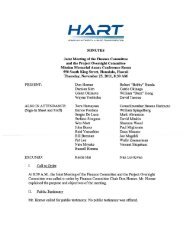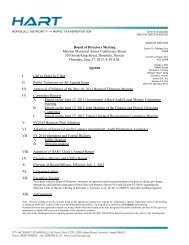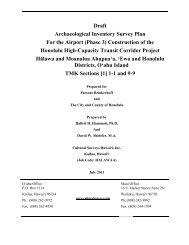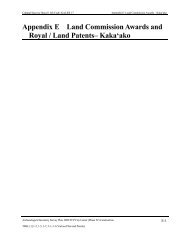4.12 Test Excavation 167 (T-167) - Honolulu Rail Transit Project
4.12 Test Excavation 167 (T-167) - Honolulu Rail Transit Project
4.12 Test Excavation 167 (T-167) - Honolulu Rail Transit Project
You also want an ePaper? Increase the reach of your titles
YUMPU automatically turns print PDFs into web optimized ePapers that Google loves.
Cultural Surveys Hawai‘i Job Code: KALIHI 23Kewalo Geographic Zonefrom Feature 1 showed no evidence of cultural modification. The Sus scrofa rib from Feature 3was butchered with a metal blade, indicating an historic origin.Sample Results: A total of six bulk sediment samples were collected from within T-<strong>167</strong>including one sample from Stratum Ii at 0.95 mbs, SIHP# 7428 Feature 1 between 1.4-1.45 mbs,SIHP# -7429 Feature 2 between 1.41-1.49 mbs, SIHP# 7429 Feature 3 between 1.40-1.48 mbs,the Stratum II/III interface between 1.45-1.50mbs, and Stratum III between 1.45-1.50 mbs. All ofthe bulk samples were wet-screened.The bulk sample collected from Stratum Ii at 0.95 mbs contained shell midden consisting ofEchinodermata Heterocentrotus mammillatus (0.9 g).The bulk sample collected from Feature 1 at 1.4-1.45 mbs contained Nertidae Nerita picea 1.9 g,possibly burned crustacean (0.7 g), naturally-deposited, water-rounded marine shell (nonmidden)(0.8), and a metal fragment (0.4 g).The bulk sample collected from Feature 2 at 1.41-1.49 mbs contained naturally-occurring, waterroundedmarine shell (2.8g), rusted metal fragments (4.1 g), and fish bone (0.1 g).The bulk sample collected from Feature 3, between 1.40-1.48 mbs contained charcoal (0.2 g),Neritidae Nerita picea(4.7 g), Isognomidae (1.2 g), Isognomidae Isognomon sp. (0.3 g),possibly burned Conidae Conus sp. (0.9 g), Strombidae Strombus sp. (0.3 g), Mitridae (0.3 g),Crustacean (2.2 g), Echinodermata spp. (1.7), Mytilidae Brachidontes crebristriatus (1.3 g),rusted metal fragments (4.1g), and an unidentified fish bone (0.1 g). The charcoal collected fromFeature 3 was submitted for wood taxa identification. Wood taxa analysis identified cf. Conifer(pine, fir), a historically-intorduced tree.The bulk sample collected from the Stratum II/III interface between 1.45-1.50 mbs. containedNertidae Nerita picea (0.7 g), a bottle glass fragment (3.5 g), and a rusted metal fragment (0.5 g).The bulk sample collected from Stratum III between 1.60-1.84 mbs contained shell middenconsisting of crustacean (5.2 g), Neritidae Nerita picea (3.4 g), Echinodermata mathaei sp. (2.2g), and naturally occurring shell (7.4 g).The results of sample analysis documented the presence of historic artifacts within SIHP# 7429Features 1-3. Wood taxa analysis identified cf. Conifer (pine, fir), a historically-intorduced tree,within Feature 3. Food refuse, including possible marine shell midden represented by variousspecies and fish bone, was also identified.GPR Discussion: A review of amplitude slice maps indicated no linear features which mightindicate the presence of utilities. Reflectivity was relatively uniform throughout the grid anddecreases with depth. A transition from higher reflectivity to lower reflectivity was observed atapproximately 0.5 mbs and increases again around 0.75 mbs.GPR depth profiles for T-<strong>167</strong> identified horizontal banding, commonly associated withstratigraphic layering, throughout the survey area. This banding corresponded to variations ofdensity and chemical composition within fill deposits. The profile also indicated a change inreflectivity occurring around 0.15 mbs. Anomalies were observed in the profile but were notencountered during excavation. The maximum depth of clean signal return was approximately1.0 mbs.HHCTCP City Center (Section 4) AIS Report, Vol. IV C 763TMK: [1] 1-2, 1-5, 1-7, 2-1, 2-3 (Various Plats and Parcels)
















